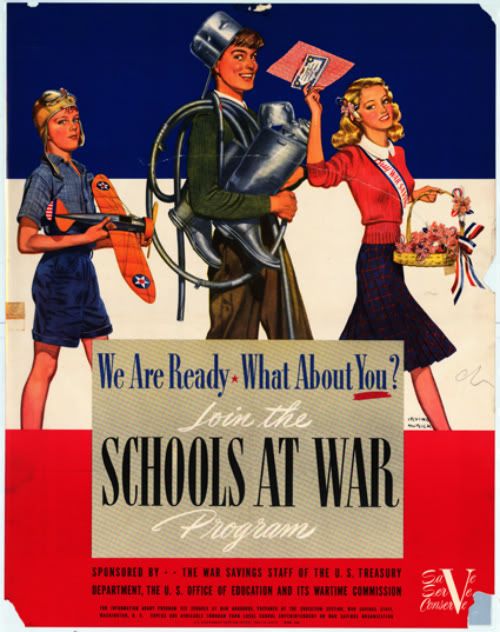One thing that has often disturbed me, as a teacher, is how the U.S. government is willing to make serious cuts to education while at the same time increasing the military budget. Another, less talked about aspect of the education/war debate is the impact that war has on school curriculum. In a fascinating paper entitled “Mobilizing for Victory: The World War II Home Front in the Schools of Fullerton, California,” Kathleen M. Traeger looks carefully at the impact of the war on school curriculum.
Two programs were created in the United States during World War II whose purpose was to get students behind the war effort: The High School Victory Corps and the Schools At War Program. These programs were implemented in schools all over the United States, including Fullerton (see also The Impact of the War Upon American Education by I.L. Kandel).
The purpose of the High School Victory Corps, according to Traeger, was “to encourage reform of secondary school curriculum and promote full participation of youth and personnel in war-related extra-curricular activities.” This war-based curriculum was meant to “emphasize the meaning of democracy, our own American history and traditions, and American heroes.” Courses “assigned books that highlighted patriotism and American values and ideals.”
History, English, and Social Studies courses were assigned books like Education and the Morale of a Free People, that celebrated America, justified the war, and “emphasized observing patriotic rituals for boosting morale.” Teachers were forbidden from discussing negative aspects of American history. Traeger writes, “The reporting of history in textbooks was carefully evaluated by the teachers and staff in the reporting of the war, in order not to raise any agitation.”
These curriculum changes were not just ideological; they were also practical. The purpose was to prepare students “for service in the armed forces and in industry.” For example, the “Four-Four Plan” was participated in by many high school students. Under the Four-Four Plan, “students attended regular school classes for four hours daily and worked four hours daily at the Douglas plant, to help build planes.”
In addition to the High School Victory Corps, the Schools At War program got elementary school children directly involved with the war effort, collecting scrap metal, and selling war stamps and bonds. Traeger writes, “Any school student who would collect over 100 pounds of scrap metal for the war effort would be given an award by the War Powers Board.” A seventh grade class in Fullerton put on a play called “Line Up For Victory,” which emphasized “the need to collect metals in order to defeat the “Japs.”
Reflecting on these programs, I am a little disturbed. Regardless of the moral “rightness” of World War II, I question the benefit of turning education into pro-war propaganda. As a teacher, I see my purpose as to teach students to think critically and deeply about the world. I do not see my purpose as to prepare students for war. But that was the emphasis during World War II.
I wonder if the legacy of this "propaganda" view of history still exists in American education. One thing that disturbs me, as an adult, is looking back on my own education, and the deficiencies therein. For example, in fourth grade, I had to build a model of a California Mission. When we learned about the Missions, there was little to no mention of the treatment of the Native Amerians in the Mission System. Having researched this topic, I now know that the Missions were basically west-coast slavery for Native Americans. Why didn't the curriculum mention that important fact? The purpose of education must be to tell the truth, not to gloss over unpleasant parts. If we do that, we do our children a great disservice.

